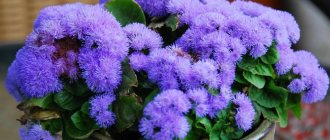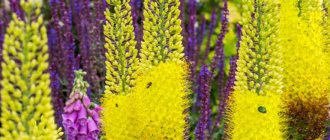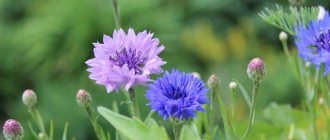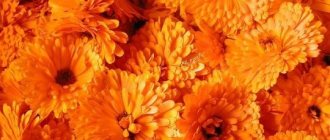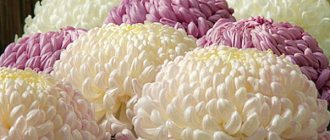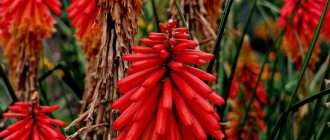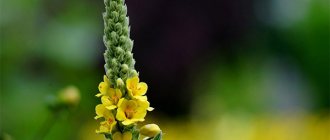Description
Cornflower is an annual or perennial herbaceous plant from the Asteraceae family up to 80 cm in height with single basket-shaped inflorescences on thin stems. A series of tubular petals with a jagged edge are attached to a small basket. Blooms from June until autumn.
The fruits are oblong grayish achenes up to 3 mm in size with a small reddish tuft.
Leaves are pubescent or smooth. Sessile linear ones are located along the stem, and pinnate lobes are located near the ground.
Cornflower easily tolerates drought and is resistant to disease. Loves sandy and loamy soils. Found in rye fields as a weed.
There are 734 species of this plant in the wild. Distributed throughout Europe.
Report Cornflower (meadow) 3rd grade message
Among the numerous representatives of the Aster family, cornflower takes pride of place. Currently, it is recognized not only by adults, but also by children.
This plant grows everywhere - both in European countries and in Russia. It can often be found in rye, deserted natural areas, forest edges, fields, and not far from residential buildings.
The branched, straight stem of the plant can reach 1 meter in length. Shoots, as a rule, have a rough surface. Its leaves are usually soft, elongated, green in color, and arranged alternately. However, the green color is disturbed by the grayish tint of the small fibers that cover the leaf blade. In this case, the lower leaves die off much earlier than the upper ones. From the beginning of summer until the very last days of autumn, cornflowers bloom with blue, purple, rarely white, pink fragrant flowers, which are collected in baskets. Each such lonely basket is located at the top of that part of the plant stem that is without leaves. According to a sad legend in which a mermaid turned her loved one into a cornflower, many are sure that this flower looks a little sad.
This piece of nature is a light-loving plant. It is considered unpretentious. It grows along dusty roads, so caring for them is not so difficult. A long time passes from the moment a seed begins to grow. The most common are blue cornflower and meadow cornflower.
Every inhabitant of the earth has encountered this plant either in reality or in works of art. Cornflower has been bringing benefits for a long time. Many years ago, substances were extracted from it to create a blue dye that was used to dye wool. However, it is considered a weed that interferes with the growth of, for example, grain crops. Therefore, in order not to spoil the harvest, many try to get rid of it. Nowadays, decoctions are often used to help cure colds and other diseases. Cornflower vinegar is made from it. Medicines containing cornflower increase appetite. It is also known as a forage plant. Gardeners actively decorate their gardens with them. The plant is an excellent honey plant. Bees hover over its flowers, actively extracting nectar. Cornflower is an ornamental plant. Its appearance delights regardless of where it is planted - in flower beds or occupies most of the balcony.
Today, cornflower has been added to the Red Book list as a specially protected plant.
Reproduction methods and varieties
Annual and perennial cornflowers are bred in different ways: the former are planted only with seeds, while the latter are sown and grown by dividing the bush. To achieve earlier flowering, both are sown as seedlings.
Summer residents prefer perennial species that can grow in one place for up to 10 years.
Cornflower has been cultivated as a garden flower since the mid-16th century.
Plants are planted in flower beds, used in mixborders, alpine slides, and used as borders.
| Annuals | |
| Wild view | Variety |
| Cornflower blue, field or blue. (Centaurea cyanus) | f. alba plena hort. f. plena azurea f. plena rosea f. plena carminea |
| Black Ball | |
| Blue Diadem | |
| Florence Pink | |
| Musk cornflower (Centaurea moschata) or musk amberboa (Amberboa moschata) | Bride |
| Morgan |
| Perennial | |
| Wild view | Variety |
| Fisher's cornflower (Centaurea fischeri) | No cultivated varieties |
| Russian cornflower (Centaurea ruthenica). | No cultivated varieties |
| White cornflower (Centaurea dealbata or Psephellus dealbatus) | John Courts |
| Soft cornflower (Centaurea mollis) | No cultivated varieties |
| Large-headed cornflower (Centaurea macrocephala) or large-headed cornflower (Grossgeimia macrocephala). | No cultivated varieties |
| Mountain cornflower (Centaurea montana). | Parham |
| Grandiflora | |
| Alba | |
| Rosea | |
| Violetta |
Planting seeds in open ground
Perennial and annual cornflowers are sown immediately in the flowerbed. In order to get healthy shoots, you need to choose and prepare the place correctly, and decide on the time of sowing.
Site selection and soil preparation
For planting, choose a place that is lit all day. When sowing cornflowers in a flowerbed next to other flowers, they carefully think through the overall composition: take into account the height of all the plants, their bushiness and the density of the stems. The fact is that cornflowers love sunlight and space, and in the shade they cannot achieve abundant flowering.
They prefer light loams, so in the fall lime, chalk (300 g per m2), dolomite flour or ash are added to the acidic soil. To keep the soil loose, add a bucket of sand or sawdust per 1 m².
Before sowing, the soil is dug up onto the spade and fertilizing is applied: 2 kg of peat and humus, 100 g of wood ash and 1 tbsp. l. nitrophoska per square meter.
Sowing time
Cornflowers can be planted with seeds before winter or in spring.
In the middle zone, winter sowing is carried out in October–early November, and in the southern regions – in November–early December at temperatures close to zero. In warm weather, the seeds will germinate and the seedlings will die. Gardeners know that sowing before winter allows for earlier flowering.
In the spring, cornflowers are planted in well-warmed soil: in areas with mild winters in early April, in places with more severe climatic conditions in mid-May.
If you want annual cornflowers to bloom continuously throughout the season, in the spring several more plantings are carried out at equal intervals.
Note: Perennial plants planted with seeds will produce flowers only after a year.
Landing instructions
Usually the seeds do not need additional processing, but for Fischer's cornflower and field cornflower, dry stratification is necessary. Without this procedure, the seeds will not sprout.
They are placed in plastic bags and placed on the top shelf of the refrigerator at a temperature of +1 to +5 ° C for 1–2 months before sowing in open ground or for seedlings. When planting before winter, stratification is not required.
In April–May, beds are formed on the site. The dug up soil is leveled, pressed down a little and furrows 2–3 cm deep are made.
The soil is moistened abundantly and dry or prepared seeds are planted at a distance of 5–10 cm. They are sprinkled with sifted soil on top. After this, the area is covered with a special cloth. The beds are watered every 2 days.
The first shoots appear within a week, after which the covering material is removed.
After a few days, the sprouts are thinned out, leaving 10–20 cm between them. You need to ensure that adult bushes grow freely, without interfering with each other.
Top dressing
Cornflowers are fed before flowering. To do this, take 10 liters of water and dissolve 1 tbsp in it. l. nitrophoska and urea. Water the soil under the plants with the prepared fertilizer, using 3–4 liters of the product per m². We must remember that excessive feeding leads to yellowing of the leaves.
To make the buds bloom faster, use the drug “Zircon”. In accordance with the instructions, the bush is sprayed with it before flowering.
Watering
The plants are unpretentious and need water only in severe drought.
If the leaves of the cornflower begin to fade and the flowers become smaller, this means that it does not have enough moisture. It is best to install an automatic sprinkler on the site, which can be turned on daily for a few minutes.
In rainy summers, the bushes are not watered, because for them, waterlogging is more dangerous than lack of moisture.
Trimming
To make the plants look beautiful and aesthetically pleasing, faded shoots are removed during the summer. Pruning is carried out in two ways: high and low.
In the first case, the dried inflorescences are removed, and in the second, the stem is removed 10 cm from the ground. Summer residents recommend top pruning to make the bush look fluffier and neater. Low results in the appearance of bald spots in the flowerbed.
We select conditions for annual cornflowers
It is no coincidence that cornflowers in nature can most often be found in open fields. These are cold-resistant plants, not afraid of night frosts and cold snaps, and are characterized by extreme light-loving properties. You don’t have to try to grow annual cornflowers, both the favorite and most popular blue cornflower, and rarer species, without good lighting. For cornflowers, choose the sunniest locations, open, warm or even hot. In light shade, only annual soft cornflower can be grown, but it blooms much worse in places with even weak partial shade, even though it forms the most beautiful dense thickets there of leaves that seem to be covered with a silver coating.
When planning plantings with cornflower, one more factor should be taken into account. For this annual, the key importance is lighting not the flowers, but the leaves. The sunlight should illuminate all the greenery evenly on a fairly small plant. That is why, when planting in mixed compositions with perennials and annuals, annual cornflowers are always placed in the foreground (regardless of the height of the variety). This strategy is ideal for ensuring that the sun's rays reach even the lower part of the plants. For the same reason, cornflowers cannot be used in dense plantings and dense ridges; partners are carefully selected for them, most often combined with low-growing plants than with other large annuals and perennials.
To achieve abundant and long-lasting flowering, you will have to take care to provide cornflowers with the highest quality soil, treated and of medium nutrition. This annual plant will produce a large number of spectacular and large flowers only on fertile (but not overly rich in humus) and well-drained soil that is neutral in its characteristics. It is better to avoid calcareous or excessively acidic soils for cornflowers, as well as compacted or too dry, crumbly, rocky soil.
The minimum distance comfortable for these plants is about half a meter for standard medium and tall varieties of blue cornflower. Only such a distance and the presence of free soil around will allow the plants not to darken each other. There are no special rules for planting annual cornflowers.
Growing seedlings
In April, annuals and perennials are sown for seedlings.
To do this, prepared containers are filled with soil for flowers, moistened, seeds are planted to a depth of 1–2 cm and covered with film. The container is installed at a temperature of +20–22.
Thanks to this shelter, a greenhouse effect is created, and heat and high humidity promote rapid germination. After germination, the film is removed and the container is placed in a well-lit place.
The sprouts are fed once with complex fertilizers for seedlings. When they reach 10 cm, they are transplanted into open ground to a permanent place at a distance of 30–40 cm from each other.
Annuals grown in this way open their buds 3 weeks earlier, and perennial bushes take root well by autumn and bloom the next season.
Types of garden perennial cornflowers
The genus of cornflowers has about five hundred species, which differ from each other primarily in external parameters, as well as in life expectancy (annual, biennial, perennial).
The most common types of perennial cornflowers are:
White cornflower. A plant reaching up to 30 centimeters in height, the flowers are double to the touch, the color is white. They are collected in small baskets with diameters of about five centimeters. This species is listed in the Red Book due to its rarity.
Photo. White cornflower
Mountain cornflower. The most popular of the perennial species is the representative of cornflowers. The stem of the plant reaches a meter in height, the rhizomes are very powerful, covering a large area.
Photo. Mountain cornflower
- Yellow cornflower. A bush that holds its shape well. It grows up to a meter high, which gives a good view of its bright yellow flowers, the diameter of which does not exceed five centimeters.
- Large-headed cornflower. A bush reaching 120 centimeters in height. The flowers have a diameter of up to 8 centimeters, which makes them the largest among all representatives of the cornflower genus.
Photo. Large-headed cornflower
Eastern cornflower. A wild plant whose height ranges from one to twenty meters. The leaves are divided and whole, the color is bright yellow. Flowers are collected in inflorescences.
Photo. Eastern cornflower
Meadow cornflower. Herbaceous plant. The height of the stem is 80 centimeters. The leaves are lanceolate or ovate, located at two levels: lower and upper. The lower leaves are on winged petioles, and the upper ones are closer to the flowers. The flowers are located in baskets, the color is lilac-pink. This type of cornflower is more common in Eurasia. In Europe he is poorly known.
Photo. Meadow cornflower
Whitened cornflower. It has an erect stem reaching a height of half a meter. It is one of the most popular species due to its beauty. The flowers are bright pink, up to five centimeters in diameter. It blooms in summer, from late July to late August.
Photo. Whitened cornflower
Pink cornflower. The erect and strong stem reaches a height of one meter. The inflorescences are strongly swollen. The inflorescences are solitary, up to five centimeters in diameter. The leaves are lanceolate, the color is dark green. Blooms in June and July.
Growing by dividing rhizomes
Perennial garden cornflower is propagated by dividing the bush in late August–early September after it has finished flowering. The plant is dug up, shaken off the soil, the roots are washed under water, and then divided into parts.
Each must have at least 3 formed buds. The cuttings are immediately planted in the prepared place and the ground shoots are cut off, leaving 10 cm above the soil level. To ensure that the plant takes root well, it is watered 3-4 times a week for a month. The cornflower will bloom next summer.
Application of cornflower flowers
What are the benefits of flowers? To extract all the beneficial properties of cornflowers, you need to collect the flowers at a certain time - this is at the end of July and until the beginning of August. First, the flower baskets are carefully cut off, and then thin petals are removed from them. All cut cornflower heads should be laid out on paper for further drying. This procedure is carried out in a dark room where everything is ventilated.
It is very important to protect the crop from direct sun, as it will lose its medicinal properties by 50%, and its color will also change. From time to time the dried flowers are stirred so that they dry on all sides.
Next, the harvest is placed in a dry glass jar and then in a fabric bag. Cornflowers are often used for the eyes, making tinctures and decoctions from them.
Dried cornflowers are widely used in modern medicine, for example, they help soothe coughs, improve digestive processes, dull menstrual pain, and fight colds and flu. And the use of cornflower flowers gives positive results for food poisoning, blindness, skin diseases, colic, gout, and jaundice.
Cornflower flower oil
Cornflower contains coloring substances that are a natural antioxidant, and cornflower flower oil and infusions have a beneficial effect on the human body and are also suitable for children. Flower oil also strengthens the cardiovascular and nervous system, improves skin tone, has an antibacterial effect, prevents the development of cancer, eliminates inflammatory processes and slows down aging.
Using cornflower flowers: its use can be very different. For example, it can be used to lower blood pressure, improve blood circulation, fight colds, anemia, and cleanse the body of harmful foods. The finished oil is obtained by grinding and pressing; at home, it is mixed with olive oil and used as a medicinal or cosmetic product.
Cornflower tincture
Ready-made cornflower tincture can be purchased at a pharmacy at a minimal price, but if desired, it can be made at home. For example, for abscesses or eye diseases, prepare a decoction, which will require: a teaspoon of dried cornflower flowers and a glass of boiling water, mix everything and leave for 30 minutes. Next, filter the broth and take a third of a glass on an empty stomach once a day. This water infusion of cornflower is also used externally, that is, they prepare lotions for the eyes or sore joints.
In addition to independent use, cornflower flowers are part of medicinal preparations, which include several plants at once. For example, to treat acne, a herbal mixture is prepared, which includes: dried walnut leaves, cornflower flowers, string, horsetail, nettle, speedwell and pansies. Mix all the herbs, take 4 tablespoons of the mixture and pour a liter of boiling water. It will take 10-12 hours for the cornflower tincture to be ready, after which it is filtered and taken as a lotion.
Diseases and pests
Cornflowers are resistant to most diseases, but they can be affected by mites or fungi.
Sometimes plants become infected with fusarium. The leaves of the flower turn yellow and fall off after a while. To prevent the spread of the disease, the damaged parts are removed and the stem is treated with fungicidal preparations.
When bushes are infested by spider mites, the leaves turn yellow and spots appear on them. To destroy the pest, the plant is sprayed with insecticides. Damaged parts are removed.
Important! Bushes that are over-watered are more likely to get sick. Overwatering weakens cornflowers and they become vulnerable. It is necessary to control soil moisture and, if necessary, plant plants on a high bed or arrange drainage.
